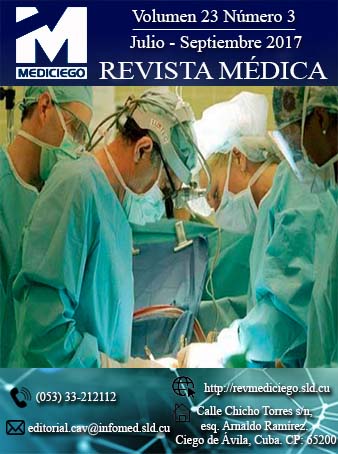Sacrococcygeal chordoma
Abstract
Introduction: chordomas are rare tumors, whose degree of malignancy ranges from low to intermediate. They are derived from the notochord and grow slowly. Its incidence is 0,1 % cases per million inhabitants and represent 1-4 % of the primary malignant bone tumors.
Objective: to report on the first case of a patient with sacrococcygeal cordoma, diagnosed in the Provincial Teaching Clinical Surgical Hospital "Manuel Ascunce Domenech" of Camagüey.
Case presentation: 60 years old female patient. A year before, she manifested pain in the sacral region, intense and sharp, located at the beginning and subsequently irradiated to the right sciatic region. Due to this she experienced impediments to the march. Other symptoms were urinary retention, rectal bleeding and constitutional syndrome. During rectal examination, a presacral tumor was detected, with a hard, painful consistency of approximately 10 x 7 cm. The patient underwent surgery and radiotherapy.
Discussion: the clinical manifestations are closely related to the location of the tumor and are, mainly, gastrointestinal and nervous. However, the most frequent cause of medical consultation is pain. Histologically, the tumor is formed by notochordal tissue, which is formed by physaliferous cells. Therefore, other neoplasms must be taken into account as differential diagnoses.
Conclusions: sacrococcygeal chordoma is a rare and poorly studied tumor. Its symptoms are common to other disorders, which makes early diagnosis difficult. However, its course has a good prognosis, with a high degree of cure, due to the combination of surgical treatment and radiotherapy.Downloads
Published
How to Cite
Issue
Section
License
Copyright (c) 2021 Pedro Rosales Torres, Rafael Pila Pérez, Rafael Pila Peláez

This work is licensed under a Creative Commons Attribution-NonCommercial 4.0 International License.
Those authors who have publications with this journal accept the following terms of the License CC Attribution-NonCommercial 4.0 International (CC BY-NC 4.0):
You are free to:
- Share — copy and redistribute the material in any medium or format for any purpose, even commercially.
- Adapt — remix, transform, and build upon the material for any purpose, even commercially.
The licensor cannot revoke these freedoms as long as you follow the license terms.
Under the following terms:
- Attribution — You must give appropriate credit , provide a link to the license, and indicate if changes were made . You may do so in any reasonable manner, but not in any way that suggests the licensor endorses you or your use
- No additional restrictions — You may not apply legal terms or technological measures that legally restrict others from doing anything the license permits.
The journal is not responsible for the opinions and concepts expressed in the works, which are the exclusive responsibility of the authors. The Editor, with the assistance of the Editorial Committee, reserves the right to suggest or request advisable or necessary modifications. Original scientific works are accepted for publication, as are the results of research of interest that have not been published or sent to another journal for the same purpose.
The mention of trademarks of specific equipment, instruments or materials is for identification purposes, and there is no promotional commitment in relation to them, neither by the authors nor by the editor.






















